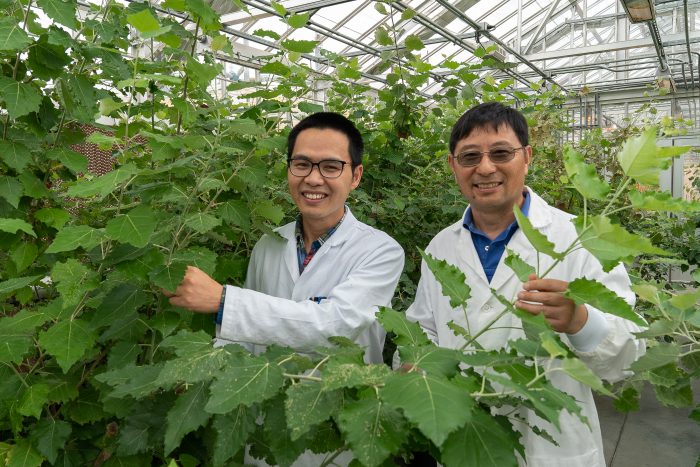BNL’s Chang-Jun Liu finds way to boost plant chemical used in toothpaste

By Daniel Dunaief
Plants not only make our food, produce the oxygen we breathe, and provide key ingredients in medicines, but they could also contribute chemicals that might otherwise require fossil fuels to produce.
Scientists have known since 1955 that poplar trees produce small amounts of a product called p-hydroxybenzoic acid that they attach to the lignin in their cell walls. What they didn’t know, however, was how they were attached.
After years of cloning genes and, more recently, using the gene editing tool CRISPR, Chang-Jun Liu, a plant biochemist at Brookhaven National Laboratory, and collaborators in Japan discovered the gene that codes for an enzyme that catalyzes the attachment of pBA to the lignin.
Up to now, companies have produced pBA by using fossil fuels as raw materials and for the energy required to generate enough heat and pressure for the catalytic reactions.
This discovery, which Liu published in the journal Nature Plants, could provide a more eco-friendly way to produce a chemical involved in the manufacture of toothpaste, shampoos, commercial moisturizers, shaving gels, and spray tanning solutions, among other products.
The global market value of p-hydroxybenzoic acid was $59 million in 2020 and is expected to climb to $80 million in the next five years.
“We wanted to identify the enzyme that is responsible for attaching pBA into lignin and reconstitute this pathway and promote its storage in the cell wall,” Liu said. Ideally, he’d like to combine the pathways that produce the donor molecule containing pBA with their enzyme to promote pBA storage in cell walls.
Once Liu found the gene responsible for that enzyme, he did what scientists typically do to check on the importance of a genetic sequence: first, he knocked it out and second, he overexpressed it.
By knocking out the genetic sequence, he found that poplar trees stopped producing pBA. Overexpressing the gene, on the other hand, not only increased the amount of this chemical by about 48 percent, but also raised the strength of the lignin and, consequently, the durability of the cell wall.
Aside from the benefit of increasing the natural production of the chemical, changing the amount of pBA could have implications for the environment and industry. Less durable lignin, which has a lower amount of pBA, could be useful in producing pulp, paper and biofuel, making it easier to access the biomass of the wood.
More durable lignin could be useful in the timber industry, while also enabling the plant to remove more carbon, mostly in the form of carbon dioxide, from the air.
“If we can engineer the plant to produce more of this carbon-dense compound, … particularly in the root, we can fix more carbon into the underground fraction, which will absorb more carbon from the air to promote carbon sequestration,” Liu said.
A long process
The work that led to identifying the gene that codes for the enzyme that attaches pBA to lignin took about 15 years.
Liu knew this enzyme worked to attach pBA, among other chemicals, in a test tube, but the journey to prove its importance in the poplar trees took considerable work.
Liu cloned 20 genes that are expressed in woody tissues and encoded enzymes called acyltransferases. While expressing these enzymes, he mixed them with an isotope-labeled carbon, which allowed him to check to see whether the enzyme contributed to the process of attaching pBA to lignin.
He tried using RNA interference to knock down the targeted gene, but that didn’t work.
The breakthrough that established the importance of this gene came when Liu used CRISPR.
Next steps
Scientists aren’t sure of the specific steps or even why plants produce pBA in the first place.
Plants produce pBA through the shikimate pathway, but the exact routes leading to pBA formation are still undiscovered.
As for why plants produce pBA, one hypothesis is that the plant uses a higher amount as a defense mechanism, making its lignin harder to remove for an insect. It could also provide resistance to mechanical stress caused by wind or snow.
“We do not have solid evidence to prove that,” he said, but “we need to explore that further.”
Liu also hopes to take a synthetic biology approach to build a more effective pathway by using the enzyme to make the plant a partner in producing pBA and in capturing and storing organic carbon.
The biochemist hopes to find a commercial partner who might be interested in exploring the development of a process that occurs naturally in poplar trees.
The environmental impact of increasing pBA in plants on the ecology of the areas in which these poplar trees might grow is unclear.
“We do not know at this moment whether this will benefit or be harmful to the soil microbial community,” he said. “In some cases, it can help the plant absorb more nutrients. It potentially can also kill other microbial life.”
For the plant, it’s unclear what the effect of higher pBA might be. The enzyme Liu identified moves pBA from inside the cell to the cell where, which would likely mitigate any toxicity because that is dead material.
“We expect the increase of cell wall-bound pBA should promote the trees’ ability in withstanding environmental changes,” he explained.
Altering the cell’s metabolic processes by rebuilding a new pathway that produces high amounts of pBA could negatively affect a tree’s normal growth. Liu would need to conduct more experiments to explore this possible effect.
A resident of Rocky Point, Liu lives with his wife Yang Chen, who is a special education teacher assistant at Rocky Point Middle School. Their son Allen is in his third year at Purdue University, while Bryant is in his second year at the University of Southern California. The family enjoys skiing and hiking trips.
The work to confirm the link between the gene and the production of pBA involved numerous post doctoral researchers.
Liu appreciates the effort of his research team over the years. “I’m very happy that we were finally able to resolve this issue,” he said.






